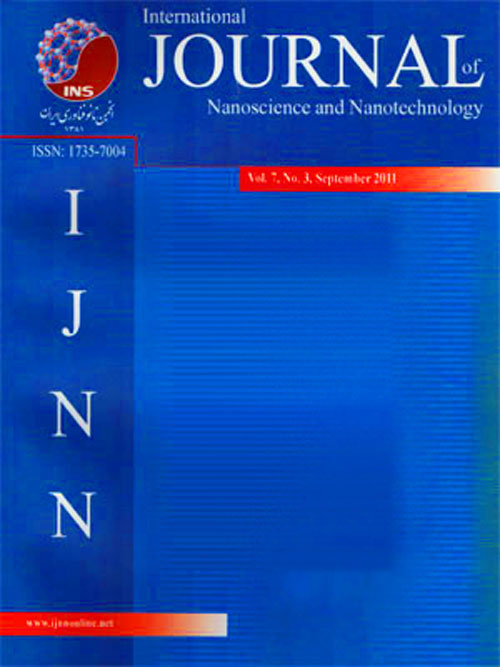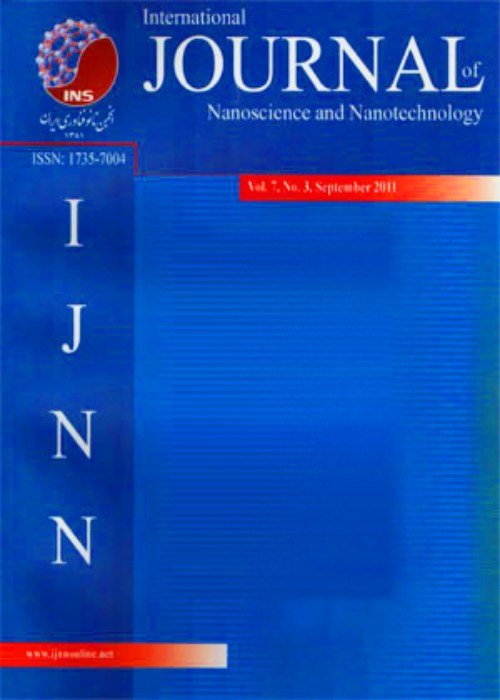فهرست مطالب

International Journal Of Nanoscience and Nanotechnology
Volume:16 Issue: 3, Summer 2020
- تاریخ انتشار: 1399/06/12
- تعداد عناوین: 6
-
-
Low Power and Low Latency Phase-Frequency Detector in Quantum-Dot Cellular Automata NanotechnologyPages 145-152Nowadays, one of the most important blocks in telecommunication circuits is the frequency synthesizer and the frequency multipliers. Phase-frequency detectors are the inseparable parts of these circuits. In this paper, it has been attempted to design two new structures for phase-frequency detectors in QCA nanotechnology. The proposed structures have the capability of detecting the phase differences of the rising edge or falling edge of their inputs. Also, it can detects frequency differences of its two inputs. In the design of proposed PFDs D flip-flop with few number of cells, area and low delay is used. The proposed PFD circuits in QCA technology have 159 quantum cells, 0.2 µm2 of occupied area, and 1 clock cycle delay for reset path. In comparison to the previous PFD in QCA technology, the proposed designs have ability to detect phase differences more than half of the period of reference signal. That means the capture range of them are approximately 4π (between -2π to 2π). Also, the power simulation of the proposed structures of phase-frequency detector is presented in this paper.Keywords: PFD, QCA, power, Delay, Phase-Frequency detector.
-
Pages 153-165In this paper, a facile and eco-friendly method for the preparation of Ni nanoparticles (Ni NPs) has been described based on the bioreduction of aqueous Ni(II) precursors with Phlomis cancellata Bunge extract. UV-visible spectrum of the aqueous medium containing Ni nanoparticles showed a peak of 390 nm. Since the experimental conditions of this procedure play vital roles in the synthesis rate of the NPs, a response surface methodology using the central composite design was employed for testing the reaction variables. The individual and interactive effects of process variables (temperature, time, concentration of Ni(NO3)2 and pH) upon extracellular biological synthesis of Ni NPs by Phlomis cancellata Bunge were studied. The statistical and perturbation plot analysis suggest that a reaction temperature of 90 °C, duration of 30 min., pH of 9.5 and concentration of 26 mM of Ni(NO3)2 would produce the highest amount of nanoparticles. The NPs were characterized by Scanning electron microscopy (SEM), energy dispersive X-ray spectroscopy (EDX), UV-Visible, and Infrared spectroscopy (IR). The SEM image of Ni NPs showed that the particle shape varied from spherical to polyhedral and ranged between 15 to 25 nm in size. These Ni NPs were studied for their potential role in photocatalytic degradation of safranin dye under solar light irradiation. At optimized conditions, up to 90% safranin dye degradation was achieved.Keywords: Photocatalytic degradation, Safranin, Phlomis cancellata Bunge, Nickel nanoparticles.
-
Pages 167-179Historically, DNA molecules have been known as the building blocks of life, later on in 1994, Leonard Adelman introduced a technique to utilize DNA molecules for a new kind of computation. According to the massive parallelism, huge storage capacity and the ability of using the DNA molecules inside the living tissue, this type of computation is applied in many application areas such as medical and engineering. Despite these advantages, DNA computing fault is prone to error. These errors may affect the entire computation and lead error in final result. Design of tolerant systems is one of the hot topics in the field of circuit design. The error in DNA computing will appear by a change in the concentration in compare to a threshold. In this paper, a buffer to modify the level of concentration is introduced and the number of required buffers in order to reduce the overhead caused by additional buffers in system is investigated using normal distribution. Designed system will modify any error with 15% changes in output concentration level in compare to a threshold level using the proposed method, which will increase the reliability.Keywords: DNA computing, Microfluidic biochips, Fault tolerant, Reliability, DNA circuit.
-
Pages 181-188In recent years, Hyperthermia has been used as an emerging technique for cancer treatment, especially for localized tumors. One of the promising cancer treatment approaches is magnetic nanoparticle (MNPs) Hyperthermia. In this theoretical work, the temperature distribution of a common tumor over the different sizes of Fe3O4 magnetic nanoparticles, namely 25, 50, 100, and 200 nm, was studied via the finite element method. A two-dimensional method was used to simulate the tumor tissue, in which nanoparticles were incorporated and dispersed into the tumor uniformly. The bio heat transfer equation (BHTE) was applied to calculate the thermal processes in the human body. Results elucidated that decreasing magnetic nanoparticle size caused more temperature rise in the tumor cell during the Hyperthermia treatment, which led to better performance of the treatment. Finally, simulation results showed that the Fe3O4 magnetic nanoparticles with the sizes of 50-100 nm were applicable for Hyperthermia therapy with the optimum cellular uptake.Keywords: Hyperthermia, Magnetic nanoparticles, Size effect, Tumor, Finite element method.
-
Pages 189-200The aim of the present investigation is to synthesize Barium ferrite and Nickel ferrite Nanoparticles by co-precipitation method and these nanoparticles are used to prepare nanocomposites with poly vinyl alcohol (PVA). The composited nanoparticles are characterized by using FTIR, XRD and SEM. The synthesized nanoparticles are used as adsorbent to remove the heavy metals such as Cu2+, Cd2+, Pb2+ from simulated industrial waste water. The experimental parameters such as contact time, adsorbent dosage and pH have been studied on the percentage removal of metal ions. It is observed from the experiment, that 100% and 99.05% of Cu2+ has been removed by PVA-Barium and PVA-Nickel ferrite nanocomposites respectively. The experimental data were analyzed using the Langmuir and Freundlich isotherm. The synthesized nanoparticles have greater potential for adsorption of heavy metal ions present in simulated industrial wastewater. These nanoparticles with polymeric composites can be effectively used as adsorbents in the commercial scale to achieve the desired goal of clean environment.Keywords: Ferrite nanoparticles, Metal ions, Adsorption, Poly Vinyl Alcohol-nanocomposites.
-
Pages 201-208Zinc oxide has been considered as a promising semiconductor material for fabrication of transparent conductive oxides (TCOs), electronic devices, optoelectronics, and solar cells. Among the various morphologies of zinc oxide, nanorods are more widely used because of the ease of synthesis and providing a direct path for the transport of charge carriers. The electrochemical deposition method (ECD), due to its simplicity, low cost, and production of nanostructures with fewer defects is a more suitable method for producing zinc oxide nanorods. Heretofore, the effect of different parameters such as the temperature of growth solution, the concentration of precursors and pH on the morphology of the final product were studied. In this paper, the effect of the seed layer number on morphology, absorption, and electrical conductivity of zinc oxide nanorods was investigated using SEM images, UV-Vis spectroscopy, and four-point probe. The results showed that increasing the number of seed layers from 0 to 5 lead to the production of vertical, uniform, regular, and high-density nanorods. Also, the use of high-density zinc oxide nanorods, in the structure of polymer solar cells increased the performance of polymer solar cells by 68%. The polymer solar cell with zinc oxide nanorods as the electron transport layer showed short-circuit current, open-circuit voltage, and the power conversion efficiency of equal to 9.04 mA/cm2, 0.53V, and 2.51%, respectively.Keywords: Zinc oxide, Seed layer, Zinc oxide nanorods, Polymer solar cells.


